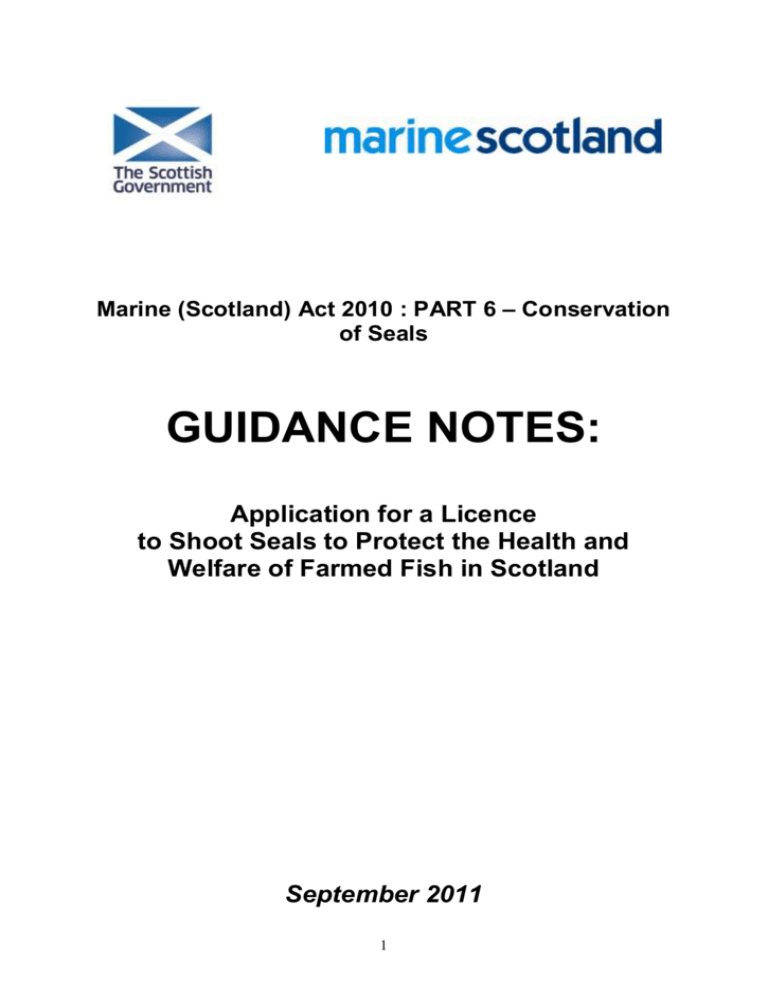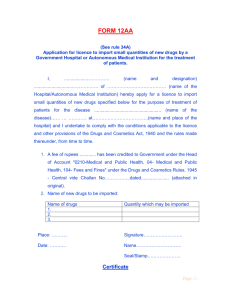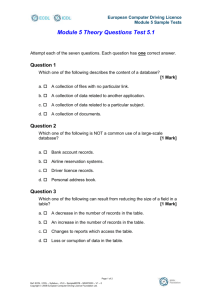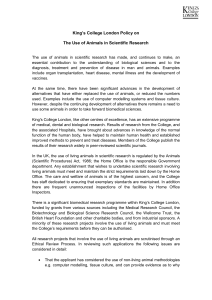Marine Scotland
advertisement

Marine (Scotland) Act 2010 : PART 6 – Conservation of Seals GUIDANCE NOTES: Application for a Licence to Shoot Seals to Protect the Health and Welfare of Farmed Fish in Scotland September 2011 1 Marine (Scotland) Act 2010 Under the Marine (Scotland) Act 2010 (the Act), section 107 it is an offence intentionally or recklessly to kill, injure or take any seal except under specific licence or for animal welfare reasons. Under section 110 of the Act, Scottish Ministers have the authority to grant licences to permit the killing or taking of seals for the following purposes: for scientific, research or educational purposes, to conserve natural habitats, to conserve seals or other wild animals (including wild birds) or wild plants, in connection with the introduction of seals, other wild animals (including wild birds) or wild plants to particular areas, to protect a zoological or botanical collection, to protect the health and welfare of farmed fish, to prevent serious damage to fisheries or fish farms, to prevent the spread of disease among seals or other animals (including birds) or plants, to preserve public health or public safety, or for other imperative reasons of overriding public interest, including those of a social or economic nature and beneficial consequences of primary importance for the environment. It is not an offence to kill or take a seal in accordance with a seal licence. Marine Scotland is the licensing authority for issuing licences to shoot seals for any of the purposes listed above. This guidance relates specifically to applications under section 110 (f) of the Act for licences to shoot seals to protect the health and welfare of farmed fish. Under this section, all fish farms will have to apply for a licence if they require to shoot seals to protect the health and welfare of their farmed fish. This guidance provides some additional clarification to assist with the process of completing the associated Application Form. The completed Application Form must be submitted by the deadline indicated by Marine Scotland or the application will be delayed and may, in some circumstances, be refused. Marine Scotland will seek advice on each application from the Sea Mammal Research Unit, Marine Scotland Science and Scottish Natural Heritage. 2 Introduction Scottish Ministers have made the following arrangements for the granting of seal licences fish farms. It is known that seal predation can cause negative effects on the health and welfare of farmed fish and, in such cases, limited shooting may be necessary to protect the health and welfare of the fish. If granted, licences will authorise shooting of a limited number of seals within an area specified and for a period specified in the licence. Licence Application Form Section 1 - Name of Licence Applicant This section requests details of the seal licence applicant. This might be the name of the relevant owner or the name of the fish farm company or the name of the local seal management group submitting the application, Applications may come from the owner or a fish farming company. Applications may also come, in some cases, from a local seal management group. In such cases, the group should be able to supervise and monitor seal management effectively since failure to do so may result, in some circumstances, in the refusal or revocation of a seal licence (ie. If the maximum number is exceeded). In both cases it should be noted that the only persons authorised to shoot seals under licence will be those specifically named as nominated marksmen in Annex B of the Application Form. Section 2 - Fish Farms covered This section requests the official name(s) of the fish farm(s) and Marine Scotland Science fish farm site registration number(s). Note:- Currently unregistered fish farms should not be included and will not be covered by any licence issued. Section 3 – Survey on Seals and Aquaculture This section requests confirmation that you will complete the Marine Scotland Survey on Seals and Aquaculture in support of your application for the current year. Marine Scotland have commissioned this survey to allow Scottish Ministers to make an informed decision on your licence application. You will be provided with a link to this survey by the Marine Scotland Seal Licensing Team. 3 Section 4 – Maximum number of seals This section requests information on the numbers of seals of each species that an applicant is seeking a licence to shoot. This should be based on a realistic assessment of the numbers of seals that the applicant considers they may need to shoot in order to protect the health and welfare of farmed fish from negative effects caused by seals at their fish farm(s). It should, wherever possible, make use of previous experience at the fish farm(s) concerned or, in cases where the fish farm is newly established, at equivalent facilities whether in the same vicinity or of a similar type. Marine Scotland will review the numbers requested in this section against the Potential Biological Removal (PBR) figures for local seal populations for each seal management area. Note:- Even where a licence has been granted, shooting of a seal should always be undertaken as a last resort. This is in accordance with the Scottish Salmon Producers’ “A Code of Good Practice for Scottish Finfish Aquaculture”. Note:- Seal identification guides will be issued with seal management licences. They are also available from: www.scotland.gov.uk/seallicensing Section 5 – Reporting This section provides information about the quarterly reporting requirements should a seal licence subsequently be granted. This includes the date and location of each seal shooting and species of each seal shot and, if possible, information on the recovery of the carcase. Note:- A copy of the Reporting form will be provided with a seal licence if granted. It is also available to download from: www.scotland.gov.uk/seallicensing Section 6 – Training Courses This section requests information on the qualifications of nominated marksmen. Note:- Any copies of nominated marksmen’s training or accreditation certificates or letters will be held by Marine Scotland. Note:- Marine Scotland must not grant a seal licence unless it is satisfied that any nominated marksman has adequate skills and experience. 4 Section 7 – Data Protection and Freedom of Information This section seeks to make you aware that Scottish Ministers may be obliged to make certain information available to meet their legal duties. Note:- The information supplied on the application form will be held by the Scottish Ministers. Scottish Ministers are a Scottish public authority and so have duties under the Environmental Information (Scotland) Regulations 2004 and the Freedom of Information (Scotland) Act 2002 to provide certain types of information held by them. The 2004 Regulations are most likely to apply to information about licences to shoot seals because it is likely to be environmental information. There are some exceptions to the duty e.g. to protect the confidentiality of commercial information. Also if the information is personal data (as defined in the Data Protection Act 1998) then, subject to certain conditions, the duty to make it available does not apply. Annex A This section requests information on individual contact who will deal with any correspondence concerning the application (or any licence which may subsequently be issued), Annex B This section requests information on the named individual(s) that the applicant wishes to be authorised to shoot seals under licence. This will include names, addresses, details of the firearms and firearms certificates. Note:- It is a requirement of the Act that a seal licence must specify the method that the licensee must use to kill seals and that in respect of shooting it must specify the type of firearm which must be used. In addition, Scottish Ministers must not grant a seal licence authorising a person to kill seals by shooting unless they are satisfied that the person has adequate skills and experience in using firearms. Licences will only be granted to persons holding a valid firearm certificate for a rifle meeting the requirements of the seal licence conditions. That is, a rifle using ammunition with a muzzle energy not less than 600 foot pounds and a bullet weighing not less than 45 grains. This effectively excludes any 0.22 rimfire rifles. Only centrefire rifles can be used, with the 0.22 Hornet using 45 grain bullets representing the lowest acceptable combination of bullet weight and energy. Note:- During 2011 Marine Scotland will be undertaking ballistic testing on a range of rifles to ascertain whether or not they may be appropriate for this purpose. The results of these tests may lead to changes in the firearms defined to be used for seal management under licence in future years. 5 Seal Licence Conditions Licence Conditions The Act specifies that a seal licence which authorises the killing of seals by shooting must impose conditions in respect of: The specific method which the licensee must use to kill seals. The type of firearm which must be used. The maximum number of seals which may be killed. The weather conditions in which a person may attempt to kill a seal. How close a person must be to a seal before attempting to shoot it. Prohibiting a person from attempting to shoot a seal from an unstable platform. In relation to the recovery of carcases. The steps which must be taken in relation to any seal injured when attempting to kill it in accordance with the licence in order to reduce the risk of it suffering unnecessarily. The Act further provides that a seal licence may impose conditions in respect of: The period of validity of the licence. The area in which seals may be killed. The species of seal which may be killed. The circumstances in which seals may be killed. Any period during which seals may not be killed or taken, for example, when females of the species of seal for which the licence has been issued are likely to be in an advanced stage of pregnancy or have dependent pups. Other conditions may be applied as appropriate Note:- Failure to comply with a condition imposed on a seal licence is an offence. 6 General Issues A full copy of each licence granted will be sent to the local constabulary in the area to which licence applies. Licences may be suspended or revoked at any time and should then be surrendered to Marine Scotland immediately. When to apply for a licence All licence applications must be submitted by the deadline announced by Marine Scotland which will be at least six weeks prior to the period to which the licence applies. How to apply for a licence Applications for a licence should be made on the relevant application form, which should be completed and sent to: Seal Licensing Marine Scotland Marine Laboratory PO Box 101 375, Victoria Road Aberdeen AB11 9DB Tel No: E-mail: 01224 295579 seal.licensing@scotland.gsi.gov.uk Note:- Failure to complete any relevant section of the form may result in delays in the processing of your application and may, in some circumstances, result in refusal of a licence. Note:- Marine Scotland or their representatives may visit the site during assessment of an application in order to verify information provided on the application form and to discuss, for example, any current or past negative effects, or any preventative measures currently employed or used in the past. 7 Licensing Process Marine Scotland will consult with Sea Mammal Research Unit, Scottish Natural Heritage and Marine Scotland Science about each application on a case by case basis. It will then consider the merits of each individual application in light of consultees comments and in the context of the PBR. Seal Licence Applications Submitted Clarification process Marine Licensing Team Consultation with Statutory Advisers Dialog Marksmen Skills & Experience Checks Marine Policy Team Police Firearm Licence Checks Marine Licensing Team Seal Licence Applicants Dialog Clarification process Seal Licence Issued 8 Marine Policy Team



